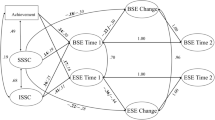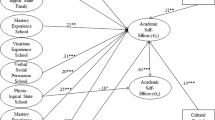Abstract
The present study focused on the relations between the self-efficacy, social self-concept, time perspectives, school investment and academic achievement of students in four different European countries and in different adolescence periods. A total of 1623 students completed questionnaires. The relations between the concepts proved not to be specific to the Western or to the former Communist bloc countries studied. The expected general decline in investment and academic achievement over the adolescence period showed up in all four countries studied. Contrary to our hypothesis, however, this decline could not be explained by growing influences of either social self-concept or time perspectives regarding personal development on their investment. In fact, the effects of social self-concept were strongest for the youngest adolescence group. Students’ social self-concept was the best predictor for their investment, while self-efficacy proved to predict academic achievement best in all adolescence periods.
Résumé
La présente étude est centrée sur les relations entre efficacité de soi, concept social de soi, perspectives futures, investissement scolaire et performance scolaire, pris à différentes périodes de l’adolescence et provenant de quatre pays européens différents. En tout, 1623 élèves ont rempli les questionnaires. Les relations entre les concepts se sont révélées n’être pas spécifiques à un type de pays, en l’occurrence un pays occidental ou un ex-pays de l’Est. La diminution escomptée en termes d’investissement et de performance au cours de l’adolescence se manifeste dans tous les pays. Du point de vue du développement personnel en lien avec l’investissement consenti, ce déclin n’a cependant pu être expliqué, comme nous nous y attendions, par les influences croissantes ni du concept social de soi ni des perspectives futures. Le concept social de soi joue même le rôle le plus important auprès des plus jeunes adolescents. Pour prédire leur investissement, cet aspect s’est révélé le meilleur indicateur tandis que l’efficacité de soi est le meilleur indicateur pour prédire la performance de toutes les périodes de l’adolescence.
Similar content being viewed by others
References
Arbuckle, J.L., & Wothke, W. (1999).Amos 4.0 User’s Guide: SmallWaters Corporation.
Bandura, A. (1993). Perceived self-efficacy in cognitive development and functioning.Educational Psychologist, 28(2), 117–148.
Bandura, A. (1997).Self-efficacy: The exercise of control. New York: Freeman and Company.
Bong, M., & Skaalvik, E.M. (2003). Academic self-concept and self-efficacy: how different are they really?Educational Psychology Review, 15(1), 1–40.
Browne, M.W., & Cudeck, R. (1993). Alternative ways of assessing model fit. In K.A. Bollen & J.S. Long (Eds.),Testing structural equation models (pp. 136–162). Newbury Park, California: Sage.
Byrne, B.M., Shavelson, R.J., & Muthén, B. (1989). Testing for the equivalence of factor covariance and mean structures: The issue of partial measurement invariance.Psychological Bulletin, 105, 456–466.
Damon, W., & Hart, D. (1982). The development of self-understanding from infancy through adolescence.Child Development, 53, 841–864.
Deci, E.L., & Ryan, R.M. (1985).Intrinsic motivation and self-determination in human behavior. New York: Plenum.
Deusinger, I. (1986). Die Frankfurter Selbstkonzeptskalen (FSKN). Göttingen: Hogrefe.
Eccles, J.S., & Midgley, C. (1989). Stage/environment fit: Developmentally appropriate classrooms for early adolescents. In R. Ames & C. Ames (Eds.),Research on motivation in education (vol. 3, pp. 139–181). New York: Academic Press.
Enders, C.K., & Bandalos, D.L. (2001). The relative performance of full information maximum likelihood estimation for missing data in structural equation models.Structural Equation Modeling, 8, 430–457.
Erikson, E.H. (1968).Identity, youth and crisis. New York: Norton.
Fend, H. (1984). Selbstbezogene kognitionen und institutionelle bewertungsprozesse im bildungswesen: Verschonen schulische bewertungsprozesse den “Kern der persönlichkeit”? [Generalized self-evaluation and institutional evaluations in the German educational system: How does evaluation touch personality].Zettschrift für Soziologie der Erziehung und Sozialisation, 4(2), 251–270.
Gjesme, T. (1975). Slope of gradients for performance as a function of achievement motives, goal distance in time and future-time orientation.Journal of Psychology, 91, 143–160.
Hascher, T. (2003). Well-being in school — Why students need social support. In P. Mayring & C. von Rhöneck (Eds.),Learning emotions — The influence of affective factors on classroom learning (pp. 127–142) Bern Lang.
Hascher, T. (2004).Wohlbefinden in der schule [Well-being in school]. Münster: Waxmann.
Hattie, J. (1992).Self-concept. Hillsdale, NJ: Erlbaum.
Hofstede, G. (2001).Cultures consequences: Comparing values, behaviours, institutions, and organizations across nations. Thousand Oaks, CA: Sage.
Inglehart, R. (1997). Modernization and postmodernization. Princeton, NJ: Princeton University Press.
Klineberg, S.L. (1967). Changes in outlook on the future between childhood and adolescence.Journal of Personality and Social Psychology, 7, 185–193.
Lens, W. (1986). Future time perspective: A cognitive-motivational concept. In D.R. Brown & J. Veroff (Eds.),Frontiers of motivational psychology (pp. 173–190). New York: Springer-Verlag.
Little, R.J.A., & Rubin, D.B. (1987).Statistical analysis with missing data. New York: Wiley.
Maehr, M.L., & Braskamp, L.A. (1986). The motivation factor: A theory of personal investment. Lexington, Massachusetts/Toronto: Lexington Books.
Markus, H., & Wurf, E. (1987). The dymaic self-concept: A social psychological perspective.Annual Review of Psychology, 38, 299–337.
Mayring, P., & von Rhöneck, C. (Eds.). (2003).Learning emotions — The influence of affective factors on classroom learning. Bern: Lang.
McClelland, D. (1961).The achieving society, Princeton: Van Nostrand.
Midgley, C., Maehr, M.L., & Urdan, T. (1993).Manual Patterns of Adaptative Learning Survey (PALS). Ann Arbor: University of Michigan.
Nelson, M., & Shavitt, S. (2002). Horizontal and vertical individualism and achievement values: A multimethod examination of Denmark and the United States.Journal of Cross Cultural Psychology.33, 439–458.
Pajares, F., & Urdan, T. (2003). International perspectives on adolescence. Greenwich: Information Age Publishing.
Peetsma, T.T.D. (1985).Meting van toekomstperspectief bij leerlingen van mavo, havo en vwo [Measurement of Dutch secondary students’ perspectives concerning their future]. Amsterdam: SCO van de Universiteit van Amsterdam.
Peetsma, T.T.D. (1992).Toekomst als motor? Toekomstperspectieven van leeringen in het voortgezet onderwijs en hun inzet voor school [The future as an incentive? Second school students’ perspectives concerning their future and their personal investment in school] (Doctoral dissertation). Amsterdam: SCO van de Universiteit van Amsterdam.
Peetsma, T.T.D. (1997).Decline in pupils’ motivation during secondary education. Paper presented at the 7th EARLI Conference in Athens (August).
Peetsma, T.T. (2000). Future time perspective as a predictor of school investment.Scandinavian Journal of Educational Research, 44, 177–192.
Piaget, J. (1955). The development of time concept in the child. In P. Hoch & J. Zubin (Eds.).Psychopathology of childhood (pp. 34–44). New York: Grune & Stratton.
Pintrich, P.R., & DeGroot, E. (1990). Motivational and self-regulated learning components of classroom academic performance.Journal of Educational Psychology, 82, 33–40.
Raynor, J.O. (1981). Future orientation and achievement motivation: Toward a theory of personality functioning and change. In G. d’Ydewalle & W. Lens (Eds.),Cognition in human motivation and learning. Leuven & Hillsdale, NJ: Leuven University Press & Erlbaum.
Raynor, J.O., & Entin, E.E. (1983). The function of future orientation as a determinant of human behavior in step-path theory of action.International Journal of Psychology, 18, 463–487.
Roede, E. (1989).Explaining Student Investment: An investigation of high school students’ retrospective causal accounts of their investment in school (Doctoral dissertation), Amsterdam: SCO van de Universiteit van Amsterdam.
Shavelson, R.J., Hubner, J.J., & Staton, G.C. (1976). Self-Concept: Validation of construct interpretations.Review of Educational Psychology, 46, 407–441.
Stoudhard, M.E.A., & Peetsma, T.T.D. (1999). Future time perspective: Analysis of a facet-designed questionnaire.European Journal of Psychological Assessment, 15(2), 99–105.
van Deth, J., & Scarborough, E. (Eds.). (1995).The impact of values. Oxford: Oxford University Press.
Wothke, W. (2000). Longitudinal and multi-group modeling with missing data. In T.D. Little, K.U. Schnabel, & J. Baumert (Eds.).Modeling longitudinal and multilevel data (pp. 219–240). Mahwah, NJ: Lawrence Erlbaum Associates.
Zimmernan, B.J. (2000). Self-efficacy: An essential motive to learn.Contemporary Educational Psychology, 25, 82–91.
Zorich, S., & Reynolds, W.M. (1988). Convergent and discriminant validation of a measure of social self-concept.Journal of Personality Assessment, 52(3), 441–453.
Author information
Authors and Affiliations
Corresponding author
Rights and permissions
About this article
Cite this article
peetsma, T., Hascher, T., van der Veen, I. et al. Relations between adolescents’ self-evaluations, time perspectives, motivation for school and their achievement in different countries and at different ages. Eur J Psychol Educ 20, 209–225 (2005). https://doi.org/10.1007/BF03173553
Received:
Revised:
Issue Date:
DOI: https://doi.org/10.1007/BF03173553




